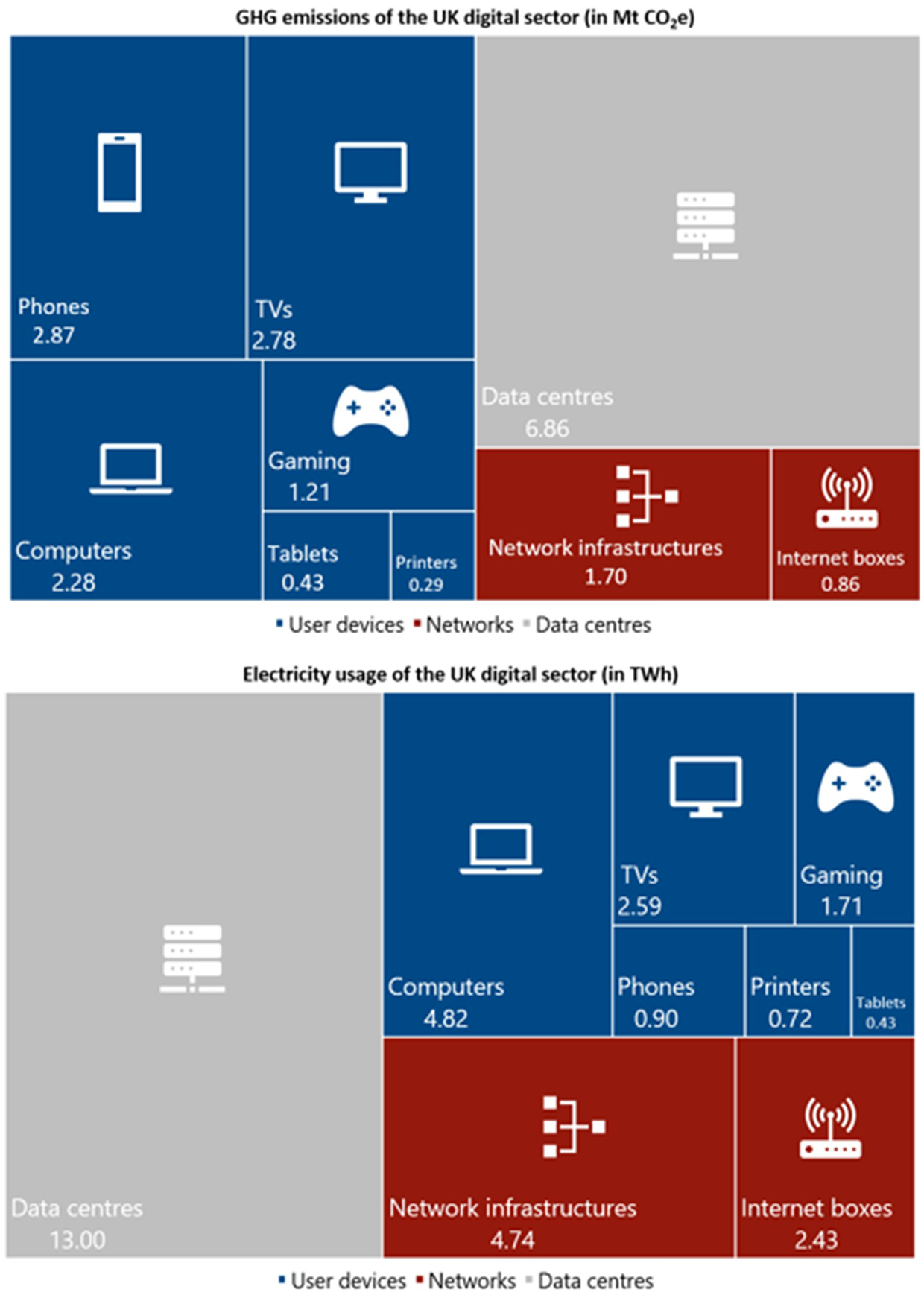The UK is committed to reaching Net Zero emissions by 20501,2 and digital technology, such as AI, will play a key role in meeting this goal by enabling technical, economic and social transformation.3 In 2018, The Royal Society4 claimed that nearly a third of the carbon emission reductions the UK needs to make by 2030 could be achieved through existing digital technology, while an analysis by the World Economic Forum suggested that digital solutions could reduce global emissions by up to 20%.5
However, alongside its potential to enable tremendous good, digital technology is also recognised as an important source of greenhouse gas (GHG) emissions. A 2021 Office for National Statistics (ONS) study6 looking at peer-reviewed estimates of Information and Communication Technology’s (ICT) GHG emissions suggested that digital sector emissions contribute to 2.1%–3.9% of global emissions. The International Telecommunication Union (ITU), together with the Global System for Mobile Communications Association (GSMA), the Global Enablement Sustainability Initiative (GESI) and the Science-based Targets initiative (SBTi) have published7 a trajectory for the decarbonisation of the digital sector, calling for an emissions reduction of 45% between 2020 and 2030, in order to limit warming to 1.5 °C.
The UK Government’s Digital Strategy aims to make the country the top global destination for technology businesses. The challenge, however, is how the UK can meet its Net Zero commitments while driving digital sector growth and harnessing digital technology benefits. The first essential step to inform future policy making is to quantify the environmental impacts of digital technology through a detailed inventory for the UK – something that has not yet been attempted in full.
The Department for Science, Innovation & Technology (DSIT) and the R&D Science and Analysis Programme at the Department for Culture, Media & Sport (DCMS) commissioned an independent six-month research-based study to better understand UK digital sector emissions. Frazer-Nash Consultancy teamed with the University of Cambridge and the University of Bristol to deliver a focused analysis of the electricity consumption, GHG emissions and wider environmental impacts associated with the UK’s digital sector. We used data-driven modelling techniques to estimate current UK digital GHG emissions and wider environmental impacts. The research involved a detailed review of available literature, insights from long standing and experienced academics working in the sector and iterative feedback from stakeholders across government.
One issue faced during the research was that there is no agreed definition of the digital sector. The ONS8 describes it as an extension of the ICT sector, which the ITU in turn defines as user devices, network goods and data centres. For this study we included TVs, printers, and gaming devices which are not part of the ITU definition but relevant to the wider digital sector.
We examined ‘embodied’ impacts (i.e. manufacturing, distribution, and end-of-life treatment), as well as ‘use stage’ impacts (i.e. the operation of digital infrastructure and hardware). In common with related research, we only considered direct effects of technology on emissions, i.e. those effects connected with the production, deployment, use, and end-of-life of digital technology. Indirect effects, such as avoided emissions arising from the enabling impact of technology, or change in consumer behaviour, were excluded as they are very difficult to reliably quantify and compare.
Result
We estimate that the digital sector contributes 19.28 Mt CO2e to the UK’s GHG emissions and 4.75% of the UK territorial GHG emissions when compared to 2021 ONS GHG statistics.9 This amounts to roughly the same level of emissions as those from the waste sector (i.e. treatment and disposal of solid and liquid waste, including landfill sites) but significantly less than the transport sector which contributed around 28% of greenhouse gas emissions. The following diagrams visually outlines an overview of our key findings.

Source: Frazer-Nash Consultancy
Task
User devices are responsible for approximately half of all emissions, with data centres contributing 35% and networks 13%. We estimate 63% of the digital sector’s GHG footprint is due to embodied emissions (i.e. manufacturing, distribution, and end-of-life disposal) and the remaining 37% result from usage or operation.
The sector’s yearly electricity demand is estimated at 31.35 TWh, representing 9.77% of the UK’s total electricity demand compared to 2022 Department for Energy Security & Net Zero (DESNZ) statistics,10 with data centres accounting for 41% of this consumption and user devices 25%. Yearly GHG emissions were estimated at 288 kgCO2e per person and 684 kgCO2e per household based on the latest available ONS census data and household estimates.
Conclusion
This study focused on a quantitative assessment of the environmental impacts of the UK digital sector, rather than on specific actions or policy recommendations which might be derived from it. Our analysis has shown the importance of continuing to decarbonise the UK energy grid, encouraging expansion of efficient, high-performance data centres across the UK, and identifying options to reduce or limit the number of devices which need to be manufactured and disposed of.
This study is the first comprehensive assessment of the environmental impacts of the UK digital sector. We hope the foundations provided by this work will be built upon in future years when more data becomes available and technologies change. Our findings underscore the importance of ongoing monitoring and evaluation of the digital sector’s environmental impacts, informing future policy and practice.
If you have any questions or would like to discuss the study, we are happy to be contacted via the email address in the author biography.
Vinesh Vegad is a Consultant in Frazer Nash Consultancy’s Sustainability and Environmental Assurance team, with experience in carbon accounting, management and reporting. Vinesh co-led this first of its kind calculation of the UK’s digital carbon footprint with Dr Loïc Lannelongue from the University of Cambridge, funded by the UK Government’s Department for Science, Innovation & Technology (DSIT) and the R&D Science and Analysis Programme at the Department for Culture, Media & Sport. Email: v.vegad@fnc.co.uk
References
- Prime Minister's Office (2025) Make Britain a Clean Energy Superpower. https://www.gov.uk/missions/clean-energy
- The British Academy(2024) Governance for Net Zero. https://www.thebritishacademy.ac.uk/publications/governance-for-net-zero/
- UK Government (2021) Digitalising our energy system for net zero. https://assets.publishing.service.gov.uk/media/60f5d393d3bf7f568dc8a58b/energy-digitalisation-strategy.pdf
- The Royal Society (2023) Computing for net zero: how digital technology can create a ‘control loop for the protection of the planet. https://royalsociety.org/-/media/policy/projects/climate-change-science-solutions/climate-science-solutions-computing.pdf
- World Economic Forum (2022) Digital solutions can reduce global emissions by up to 20%. Here’s how. https://www.weforum.org/stories/2022/05/how-digital-solutions-can-reduce-global-emissions/
- Freitag, C. et al. (2021) The real climate and transformative impact of ICT: A critique of estimates, trends, and regulations. https://www.sciencedirect.com/science/article/pii/S2666389921001884
- GSMA (2024) Setting Climate Targets. https://www.gsma.com/solutions-and-impact/connectivity-for-good/external-affairs/setting-climate-targets/
- Office for National Statistics (2015) What defines the Digital Sector? https://backup.ons.gov.uk/wp-content/uploads/sites/3/2015/10/What-defines-the-Digital-Sector.pdf
- Office for National Statistics (2022) Greenhouse gas emissions, UK: provisional estimates: 2021. https://www.ons.gov.uk/economy/environmentalaccounts/bulletins/greenhousegasintensityprovisionalestimatesuk/2021
- UK Government (2018) Future Telecoms Infrastructure Review. https://www.gov.uk/government/publications/future-telecoms-infrastructure-review





